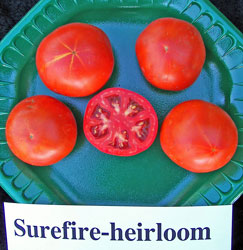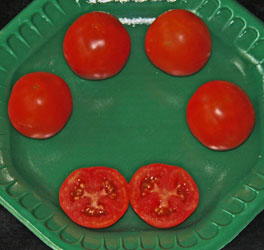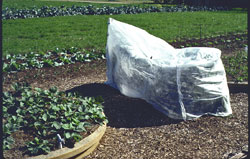How to Produce Ripened-on-the-Vine
FALL Tomato Fruit
Why NOW in July? Common sense tells us that all vegetable crops require a certain growing period before harvest can occur. Experience tells us that certain vegetables require a longer growing period than others to reach maturity (red, ripened-on-the-vine fruit) because of cooler nighttime temperatures during the last month of growing before the first hard frost will probably occur.
For instance, vegetables such as beans, cucumbers, tomato transplants, pepper transplants, squash, beets, broccoli transplants, cauliflower transplants, Swiss chard, collards, kohlrabi, lettuce, and spinach transplants require at least 2 months of growth before a crop-mature harvest can begin. Crops such as cantaloupe, potatoes, black-eyed peas (Southern peas), corn, eggplant transplants, watermelon, Brussels sprouts transplants, cabbage, carrots, onions, parsley and rutabagas require a growing period of at least 3 months before a crop-mature harvest can occur.
When you realize that the first 6 vegetable crops listed in each of the above categories are warm season vegetables which can be damaged or killed by frost, you quickly understand the urgency of planting certain fall vegetables in July. Since the San Antonio area's first frost occurs in late November, frost-susceptible crops should be transplanted as soon as possible to insure an adequate mature-fruit harvest period before cold damage occurs.
The conventional system for growing tomatoes for the fall is: “Tomato transplants should be in place by no later than July if you expect to harvest an abundant crop of vine-ripened tomatoes before cold weather arrives in the San Antonio area. Hill Country gardeners should have planted by July 1st and South-of-San- Antonio gardeners should have their tomatoes transplanted by no later than August 15th.” All of these dates are determined by “typical weather patterns” experienced in these regions by vegetable growers.
The pattern is generally: “Plant transplants by no later than July 15; use heat-setting varieties such as Surefire and Roma Surprise (9881); expect the first fall cool-down to occur a month after transplanting or around September 1; and this cool-down, especially of night-time temperatures, will cause blooms to set small fruit which will be vine-ripened in 50 to 60 days or by October.”

Surefire
|

Roma Surprise (9881)
|
This fall, horticulturists in San Antonio are going to try to help tomato lovers “beat the odds” of a crop production of vine-ripened fall tomatoes. New, fast-maturing, heat-setting varieties of tomatoes combined with some recommended cultural practices are going to be used. We basically need to have hot days (in the high 80’s or low 90’s) and cool nights (mid-to high 70’s) from the day you get your transplants at your favorite participating nursery until mid-October. Those are the conditions for maximum plant growth, optimum fruit set and optimum ripening conditions. Tomatoes usually take 50 days from fruit set to the harvest of ripe fruit. That maturity length is for large fruited tomatoes (Celebrity, Tycoon, etc.). If however, smaller fruit-size varieties are used, the time interval from fruit-set to harvest of ripened fruit will be shortened. It would also help our overall yields if we could avoid having a hard (below 32 degrees F. for several hours) freeze until mid-December.
Transplants of the ‘Surefire’ and ‘Roma Surprise’ (9881) tomato variety should be planted as they have been proven to set and ripen fruit the fastest. Smaller determinate tomatoes such as ‘Surefire’ and ‘Roma Surprise’ (9881) are more productive per square foot and should be planted two feet apart in the row or two plants per whiskey-barrel size container (For instructions about growing in containers, see:
http://aggie-horticulture.tamu.edu/archives/parsons/misc/container.html
Regardless of how good the varieties and transplants are, if prior soil preparation is not adequate, you will be doomed to failure before you begin. You should remove the weeds/grass, dig or till, fertilize with 5 pounds of a 19-5-9 slow-release fertilizer per 100 square feet (10 feet by 10 feet). Also add at least four inches of compost over the entire growing area and incorporate it into the soil.
A slow-release fertilizer such as Osmocote for containers should be used in all potting mixes regardless of label claims of fertility being included. Transplants should be watered in thoroughly at planting with a water-soluble fertilizer (Miracle Grow, Rapid Grow, Peters 20-20-20, Hasta Gro, etc.). Water-soluble fertilizer should be used EVERY time your vegetables are watered in a container in addition to having a slow-release fertilizer in the potting mix.
The best way to insure success with this plan is to use drip irrigation on ALL fall planted crops. More information about drip irrigation can be found at: http://www.plantanswers.com/garden_column/july04/2.htm
 The remedy for insect damage and contamination as well as to stimulate and enhance fruit ripening is a physical barrier of a spunweb translucent, fabric-like material. When you transplant tomatoes into the garden or a growing container, immediately install concrete reinforcing wire cages or LARGE cages purchased from a nursery. Cages are nothing more than cylinders made of reinforcing wire, hog wire or similar material to support the plant and keep the fruit off the ground. The cage also serves as a support structure for the translucent, fabric-like material known as spunweb. Adequate anchorage is essential for cages covered with spunweb during windy periods. The most commonly available spunweb product plant cover in local nurseries is the DeWitt Plant & Seed Guard (10 feet by 12 feet sheet costs $13) which is a plant protection (from cold, insects, wind, hard rain, hail, etc.) blanket or floating row cover.
The remedy for insect damage and contamination as well as to stimulate and enhance fruit ripening is a physical barrier of a spunweb translucent, fabric-like material. When you transplant tomatoes into the garden or a growing container, immediately install concrete reinforcing wire cages or LARGE cages purchased from a nursery. Cages are nothing more than cylinders made of reinforcing wire, hog wire or similar material to support the plant and keep the fruit off the ground. The cage also serves as a support structure for the translucent, fabric-like material known as spunweb. Adequate anchorage is essential for cages covered with spunweb during windy periods. The most commonly available spunweb product plant cover in local nurseries is the DeWitt Plant & Seed Guard (10 feet by 12 feet sheet costs $13) which is a plant protection (from cold, insects, wind, hard rain, hail, etc.) blanket or floating row cover.
You can also use spunweb products to "vine ripen" fruit since the plants can be completely surrounded and covered until ripening occurs. As previously mentioned, the ambient temperature is warmer in a spunweb covered structure. This additional warmth will hasten the fruit ripening process.
Use transplants of heat-setting, early maturing tomato varieties such as Surefire and Roma Surprise (9881) to insure the successful harvest of a majority of vine-ripened fruit. Healthy transplants of recommended varieties will be available at local nurseries in late July.
|



